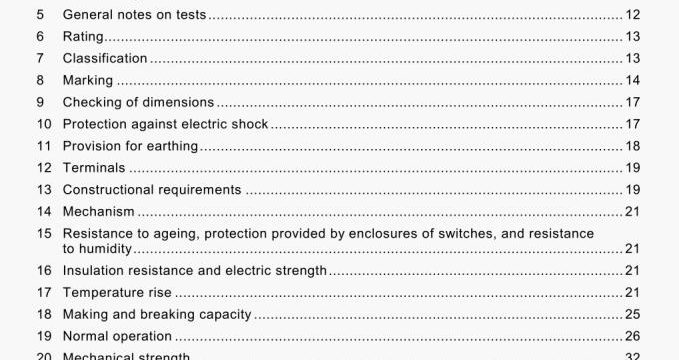Switches for household and similar fixed electrical installations
AS 60669.2.1-2020 pdf download.Switches for household and similar fixed electrical installations
Part 2.1: Particular requirements— Electronic switches.
The electronic switches are fitted with the conductors as specified in table 15, the cross- sectional area being not less than 1,5 mm2 the terminal screws or nuts, if any, are tightened with a torque equal to two-thirds of that specified in 12.2.8.
For electronic switches which can be loaded with incandescent lamps (lamps rated for the supply voltage, including halogen lamps) the following applies:
• If the rated power of some of the loads is expressed in W and is higher or equal to the rated power of other loads expressed in VA, electronic switches shall be loaded with halogen lamps or tungsten filament lamps so that, at the rated voltage of the load, the rated load will be obtained.
NOTE I As the characteristics of halogen lamps of different power are equivalent, lamps of any power can be used to reach the rated load.
• If the rated power of some of the loads is expressed in W and is lower than the rated power of other loads expressed in VA, electronic switches shall be loaded with all types of load in accordance with the manufacturer’s instructions.
• If the rated power of the self ballasted lamps. or externally ballasted lamps, expressed in W is higher than 25 % of the rated power of the in candescent lamps the test shall be done with all types of load.
For electronic switches which are not designed for incandescent lamps the following applies:
• Electronic switches for self ballasted lamps (eg. LEDI. CFLi) are loaded with lamps so that, at the rated voltage of the load, the rated load will be obtained. Dimmers shall be loaded with dimmable self ballasted lamps. If for these types of electronic switches, the maximum number of self ballasted lamps and the rating of the lamp are given by the manufacturer, the electronic switch is loaded accordingly. If more than one configuration is given by the manufacturer, the test is repeated for all configurations.
• Electronic switches for other types of lamp are tested in accordance with the manufacturer’s instructions.
Other electronic switches shall be loaded with the type of load as stated in the manufacturer’s
instructions.
NOTE 2 The rated loads are verified with the electronic switch short-circuited.
For electronic TDS, 17.1 of IEC 60669-2-3:2006 is applicable.
The electronic switches are loaded until steady-state temperature is reached at a voltage between 0,9 and 1,1 times rated voltage, whichever is the more unfavourable.
Dimmers operating with leading and trailing edge shall be tested in both modes with the relevant load.
NOTE 3 The sides of the cavity In the pinewood block may have a cylindrical shape.
The cables connected to the electronic switch shall enter through the top of the box, the point(s) of entry being sealed to prevent the circulation of air. The length of each conductor within the box shall be (80 ± 10) mm.
Surface-type electronic switches shall be mounted as in normal use, centrally on the surface of a wooden block, which shall be at least 20 mm thick, 500 mm wide and 500 mm high.
The other types of electronic switches shall be mounted according to the manufacturer’s instructions or, in the absence of such instructions, in the position of normal use considered to give the most onerous conditions.
The test assembly shall be placed in a draught-free environment for the test.
The temperature is determined by means of melting particles, colour-changing indicators or thermocouples, so chosen and positioned that they have negligible effect on the temperature being determined.
During the test, the electronic switch state shall not change, fuses and other protective devices shall not operate and the permissible temperature rises determined in table 102. column concerning clause 17, shall not be exceeded.
After this test, the electronic switch shall be in operating condition.
If sealing compounds are used, they shall not have flowed to such an extent that live parts are exposed.
Compliance is checked by Inspection.
NOTE 4 For the purpose 01 the test of 21.3, the temperature nsa of external parts of ansulating material not necessary to retain current-carrying parts and parts of the earihing circuit in position, even though they are in contact with them, is also determined.
NOTE 5 Undue oxidation of contacts may be prevented by sliding action or by the use of silver or silver-laced contacts.
NOTE 6 Pellets of beeswax (melting-point 65 ‘C) with a diameter of 3 mm may be used as melting particles.
NOTE 7 in the case of combination of electronic switches, the test is carried out separately on each electronic switch.
For the purposes of the tests of 102.2, 102.3 and 102.4.1, the reference temperature surrounding a component in an electronic switch is the maximum temperature rise measured on the component during the test plus 25 C.AS 60669.2.1-2020 pdf download.
Switches for household and similar fixed electrical installations
